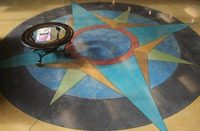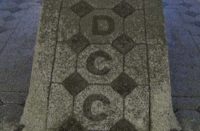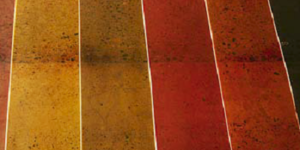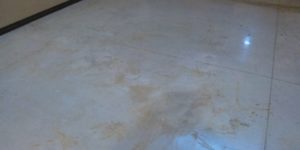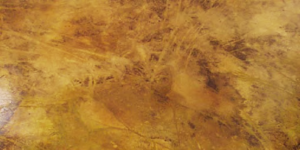
Question
I just stained a concrete floor in a new restaurant using acid stain. We used a power-trowel and the concrete had a very smooth, hard, dense finish. Then we mopped the floor with soap and water, did a clean-water rinse and let it dry overnight.
The next morning, we returned and protected the walls and sprayed the stain using a pump-up sprayer. We let the stain sit all day and came back eight hours later. The restaurant owner loved the color and the way it looked.
We then washed the floor with soap and water and removed almost all of the color. The floor now looks spotty and ugly. Why did all the color come off? And what can I do to make it look like it did before I cleaned the floor?
Answer
There are a few different things going on that led to the floor looking spotty and unacceptable. I don’t see any mention of a sample or mock-up before the project start. This would be the first red flag. I, along with most every stain manufacturer, strongly recommend sampling on all stain jobs, especially on commercial projects.
And when I talk about samples, I mean a sample in an inconspicuous place on the actual floor that will be stained. This includes all the steps that will performed on the actual project, including sealer and wax.
These types of mock-up samples are frequently placed in a closet or bathroom, or in an area where furniture or other flooring will be installed. Too often I see samples created on boards or concrete chips that have no relevance to the actual concrete floor. Sealers will significantly change the look and color of the final product, which is why you should seal the mock-up or sample.
It’s important to note that samples aren’t just about picking a color. You, as the installer, should pay close attention during the sample process to make sure the stain takes properly, the colors develop correctly and you don’t have any red-flag issues. Beware of fish-eyeing or the orange-peel effect that indicates contamination in the concrete.
Look for warning signs early
I’ve worked with installers who take the time and walk the area, spraying the entire floor with water looking for contamination or trouble spots. Today’s concrete often contains fly ash and other pozzolans and chemical admixtures. While these can be good for concrete strength, durability, finish and cost, they can often retard the stain’s ability to penetrate or develop the proper color.
A good rule of thumb is that if you have trouble getting plain water to absorb into concrete, chances are you’ll have trouble getting a stain to absorb. It’s a lot easier and cheaper to discover a concrete issue by spraying water before you’ve started the job than after you have sprayed the floor with stain.
You mentioned in your question that the floor had a “very smooth, hard, dense finish.” This should have been an immediate warning sign that the concrete was probably going to require additional preparation.
It always surprises me that many installers don’t think that floors require surface preparation for acid-stain applications. In some cases they don’t. However, in many situations, especially on commercial flooring where the concrete is machine-finished, you do.
Proper prep is a must
The surface preparation you described in your question — “We mopped the floor with soap and water, did a clean-water rinse and let it dry overnight” — falls a bit short. This is especially true for a hard, dense floor.
In many cases, a machine-finished floor requires sanding or a mild acid etch to break the concrete’s surface tension. If you use acid to etch concrete prior to acid staining, use a diluted phosphoric acid detergent to treat the floor.
In this situation, the stain looked good before cleaning because the mineral salts (which react with the concrete to produce the color) lie on the surface as residue. The concrete was both too dense and hard or some type of contamination kept the stain from penetrating and reacting.

Always remember that stains must go through a certain process to work properly. First, the surface must be porous enough for the stain to break the surface and get inside. The second is penetration, where the stain migrates into the surface paste of the concrete. The third is reaction and/or adhesion. This is the ability of the stain to react with cement-based material to develop its color.
Missing or reducing any of these three steps slows down or even stops the process, resulting in poor stain color development. Whenever I troubleshoot a stain issue, I always look at porosity, penetration and adhesion/reaction. (Similar process can be noted for dyes and sealers, too.)
Back to the original question
In regard to fixing this stained floor, start by cleaning off the residue from the first staining attempt. Then prepare the surface by sanding with a walk-behind and pad. Or, you can lightly etch with a diluted phosphoric acid detergent.
Once complete, stain the floor and consider using brooms to work the stain into the concrete. This promotes better penetration and reaction. Lastly, properly neutralize and clean the floor to get it ready for the sealer.
I strongly recommend sampling this process to dial in the right steps. This will ensure you obtain the results you desire.
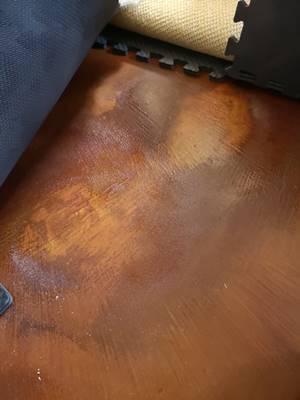
Questions from Readers
Question
I had my floors screeded and acid stained 1 year ago. It looked great initially but now I’m noticing air pockets where it looks like the stain and sealer are separating from the concrete. Additionally, there are dark acid-smelling wet spots underneath some newly placed floormats. I’ve also noticed areas that have turned white. It looks like small bubbles or gasses may still be coming off. Should I be concerned about fumes? What could cause this? My concrete guy doesn’t seem to know.
Answer from Concrete Decor
Thanks for sharing your project concerns with Concrete Decor.
Regarding the acidic smell, was the concrete neutralized after the acid-staining application? In other words, did your contractor wash or scrub it with a mixture of baking soda and water and then rinse thoroughly? If not, the concrete will maintain a high pH level until you do this. It can also be responsible for the sealer delamination you’re seeing.
We don’t recommend placing a nonbreathable mat on this type of surface. Not seeing the surrounding space, you may have moisture below the slab. When you lay a rubber mat onto your concrete surface, temperature changes can cause sweating (moisture hydration). The moisture will wick its way up through the concrete and lift your sealer off the concrete. Moisture is very powerful when it wants to go somewhere.
The coating applied to your concrete is also important to note. This can help with prescribing the proper remedy.
Question
I prepped my floor with a light mixture of etch and clean. While applying the stain, it didn’t seem to fizz. I then used a floor buffer to scrub off the residue and sucked it up with a shop vac. Then, I put on a second application of stain (which also didn’t seem to fizz). After an hour, the floor remains wet. I’m wondering, should I use TSP to clean the floor with a scrub brush and put on another coat? I tested a spot in a different area prior to staining and it became fizzy right away. My guess is the area that I tested it on wasn’t hard troweled because it’s in a closet (on the same slab though).
Answer from Concrete Decor
- Apply the Profiler.
- Let it sit for 10 to 15 minutes. (not in direct sunlight)
- Agitate it with a broom or brush on a pole.
- Scrape it all up with a broad knife or squeegee. Discard it in the trash.
- Water down the affected area and scrub lightly again .
- Remove dirty water with wet/dry vacuum.
- Allow to dry and your surface should be ready to stain.

